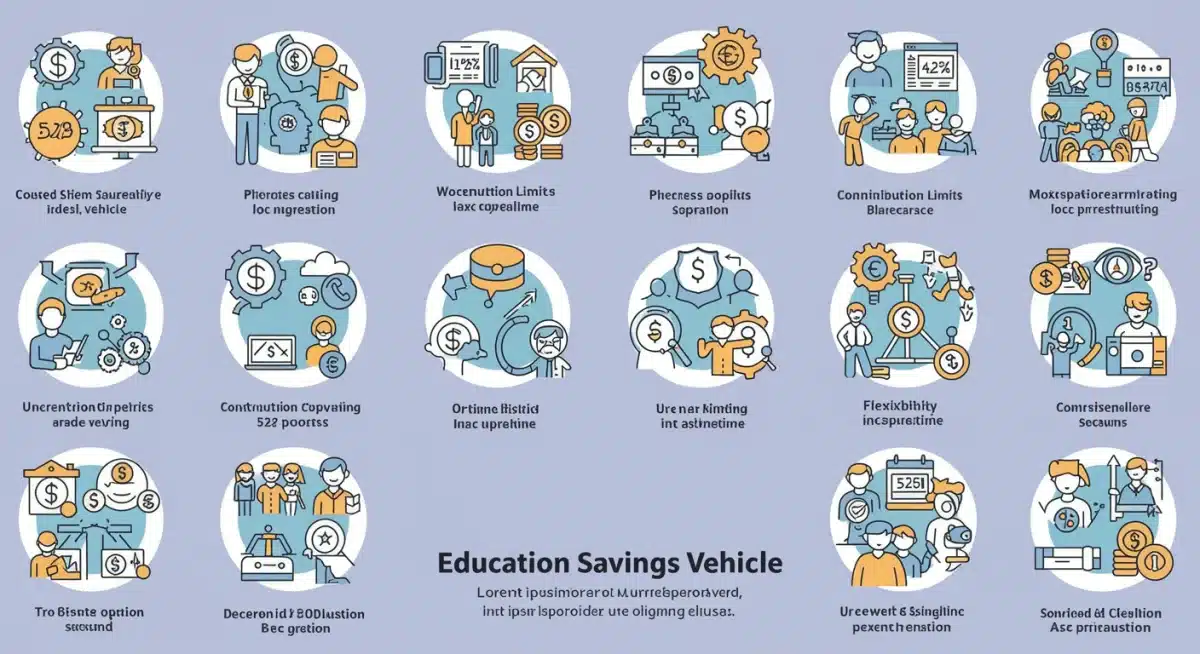Beyond 529 Plans: 2025 Tax-Advantaged Education Savings

For US parents navigating education costs, understanding tax-advantaged savings beyond the 529 plan in 2025 is crucial for maximizing financial impact and leveraging insider knowledge to secure their children’s future.
Tax-advantaged education savings in 2025, extending beyond the widely recognized 529 plan, presents a complex yet vital landscape for US parents. This year, families are seeking insider knowledge and alternative strategies to optimize their financial impact, ensuring their children’s educational futures are secure amidst evolving economic conditions and tax codes.
Understanding the 529 Plan and Its Limitations in 2025
The 529 plan remains a cornerstone of education savings, offering significant tax benefits for qualified education expenses. However, its structure and specific rules can present limitations for some families, prompting a need to explore other avenues that might offer greater flexibility or cater to unique financial situations.
Administered by states, 529 plans typically provide tax-free growth and tax-free withdrawals for eligible higher education costs, including tuition, fees, books, and room and board. Many states also offer a state income tax deduction or credit for contributions. While these benefits are substantial, parents often overlook specific nuances that might make alternative strategies more appealing depending on their financial goals and risk tolerance.
Key Features of 529 Plans
- Tax-Free Growth: Investments grow free from federal income tax.
- Tax-Free Withdrawals: Qualified education expenses can be paid for with tax-free distributions.
- Contribution Limits: Generally high, often exceeding $300,000 per beneficiary, with gift tax exclusions.
Despite these advantages, the primary limitation often cited is the use-it-or-lose-it aspect for non-qualified expenses, which incur taxes and a 10% penalty on earnings. While recent legislation has introduced some flexibility, such as rollovers to Roth IRAs, parents are increasingly looking for broader options for their tax-advantaged education savings.
Exploring Coverdell Education Savings Accounts (ESAs)
Beyond the 529, the Coverdell Education Savings Account (ESA) stands out as a highly flexible, though often overlooked, option for tax-advantaged education savings. While it shares some similarities with 529 plans, its distinct features make it particularly attractive for parents seeking more control over their investments and broader qualified expense categories.
Coverdell ESAs allow after-tax contributions to grow tax-free, with tax-free withdrawals for qualified education expenses. A significant advantage of Coverdell ESAs is their eligibility for both K-12 and higher education expenses, offering a wider scope than 529 plans. This flexibility means parents can use funds for private school tuition, tutoring, and even educational software from kindergarten through college, making it a versatile tool for comprehensive educational planning.
Advantages of Coverdell ESAs
- Broader Expense Coverage: Funds can be used for K-12 and higher education expenses.
- Investment Flexibility: Account holders typically have more control over investment choices.
- Tax-Free Growth: Earnings grow tax-free, and qualified withdrawals are also tax-free.
However, Coverdell ESAs come with income limitations for contributors and a relatively low annual contribution cap of $2,000 per beneficiary. This limit often positions Coverdell ESAs as a supplementary savings tool rather than a primary one, best used in conjunction with other strategies to maximize overall tax-advantaged education savings.
Leveraging Roth IRAs for Education Funding
For many US parents, the Roth IRA is primarily viewed as a retirement vehicle. However, its unique tax structure makes it a surprisingly powerful and flexible option for tax-advantaged education savings, especially when considering the long-term financial impact and potential for contingencies. This insider knowledge can significantly alter a family’s financial planning strategy for education.
Contributions to a Roth IRA are made with after-tax dollars, and qualified withdrawals in retirement are tax-free. Crucially for education, parents can withdraw contributions (their principal) from a Roth IRA at any time, for any reason, without taxes or penalties. Furthermore, earnings can be withdrawn tax-free and penalty-free if used for qualified higher education expenses, provided the account has been open for at least five years. This dual-purpose nature—retirement savings with a potential education funding fallback—offers unparalleled flexibility.
Why Roth IRAs are a Smart Move for Education
- Contribution Flexibility: Contribute up to annual limits, with no income restrictions for withdrawals.
- Tax-Free Withdrawals: Contributions can be withdrawn tax-free and penalty-free at any time.
- No Impact on Financial Aid: Roth IRA assets are not counted in federal financial aid calculations.
While Roth IRAs have annual contribution limits (which can be a drawback for those seeking to save large sums specifically for education), their non-qualified withdrawal flexibility and financial aid treatment make them an excellent complement to other education savings vehicles. Parents can prioritize retirement savings while knowing those funds can be tapped for education if necessary, without negative tax implications.
Custodial Accounts: UGMA and UTMA for Education
Custodial accounts, specifically Uniform Gifts to Minors Act (UGMA) and Uniform Transfers to Minors Act (UTMA) accounts, represent another form of tax-advantaged education savings that, while less commonly discussed than 529s, offer distinct advantages and considerations. These accounts allow for assets to be held for the benefit of a minor, providing a straightforward way to save and invest for a child’s future, including education.
UGMA and UTMA accounts involve transferring assets (cash, securities, or even real estate in UTMA) to a minor, managed by a custodian until the child reaches the age of majority (typically 18 or 21, depending on the state). The assets are legally the child’s, and they receive some tax benefits, such as the ‘kiddie tax’ rules allowing a portion of their investment income to be taxed at a lower rate. This can be particularly beneficial for families in higher tax brackets, offering a unique approach to tax-advantaged education savings.

Considerations for UGMA/UTMA Accounts
- Ownership Transfer: Assets become the child’s property at the age of majority, with no control for parents.
- Financial Aid Impact: These assets are considered the child’s, significantly impacting financial aid eligibility.
- Investment Options: Wide range of investment choices, similar to a brokerage account.
The primary drawback of UGMA/UTMA accounts for education planning is the irrevocable nature of the gift and the child’s complete control over the funds upon reaching the age of majority. This means the funds could be used for non-educational purposes. Despite this, for parents looking for maximum investment flexibility and some tax advantages, these custodial accounts can play a role in a diversified education savings strategy.
Employer-Sponsored Benefits and Other Niche Strategies
Beyond traditional savings vehicles, many US parents can tap into employer-sponsored benefits and other niche strategies to enhance their tax-advantaged education savings. These options, often overlooked, can provide significant financial relief and leverage existing resources effectively, adding another layer to comprehensive education funding.
Some employers offer educational assistance programs, which can include tuition reimbursement for employees or even direct contributions to employees’ 529 plans. These benefits are often tax-free up to a certain limit (e.g., $5,250 annually for tuition reimbursement) and represent a direct way to reduce out-of-pocket education costs. Additionally, for self-employed individuals or small business owners, specific deductions or credits related to education can be explored, further optimizing their tax-advantaged education savings.
Alternative Approaches to Boost Education Funds
- Employer Tuition Assistance: Tax-free benefits for employee education that can indirectly free up personal funds for children’s education.
- Savings Bonds: Tax advantages when redeemed for qualified education expenses, particularly Series EE and I bonds.
- American Opportunity and Lifetime Learning Credits: Direct tax credits that reduce college costs, often overlooked in initial savings planning.
Furthermore, strategies like gifting appreciated stock directly to a child for sale (subject to kiddie tax rules) or using whole life insurance policies with cash value accumulation can offer a unique blend of savings and tax efficiency. While these require careful planning and professional advice, they broaden the scope of what constitutes effective tax-advantaged education savings for savvy parents.
Strategic Blending of Education Savings Vehicles
The most effective approach to tax-advantaged education savings for US parents in 2025 often involves a strategic blend of multiple vehicles rather than relying solely on one. Each option—529 plans, Coverdell ESAs, Roth IRAs, and custodial accounts—offers distinct benefits and drawbacks, and combining them can create a robust, flexible, and tax-efficient education funding strategy tailored to a family’s specific needs and goals.
For instance, a parent might use a 529 plan as the primary savings vehicle for its high contribution limits and state tax benefits, while simultaneously contributing to a Coverdell ESA for its K-12 expense flexibility. A Roth IRA could serve as a valuable third layer, offering both retirement security and a tax-efficient emergency education fund. This diversified approach mitigates the risks associated with any single plan and maximizes the overall financial impact of tax-advantaged education savings.

Building a Diversified Education Savings Portfolio
- Primary Plan: Often a 529 for its substantial tax benefits and high limits.
- Secondary Plan: Coverdell ESA for K-12 flexibility and investment control.
- Fallback/Dual-Purpose: Roth IRA for retirement savings with education withdrawal flexibility.
- Supplemental: UGMA/UTMA for additional gifts, understanding the implications of child ownership.
The key is to understand the interplay between these accounts, especially regarding financial aid eligibility and tax implications. Consulting with a financial advisor specializing in education planning can provide invaluable insider knowledge, helping parents navigate the complexities and design a customized strategy that optimizes their tax-advantaged education savings for the long term.
Savings Vehicle |
Key Benefit |
|---|---|
529 Plan |
Tax-free growth and withdrawals for higher education. |
Coverdell ESA |
Tax-free for K-12 and higher education, investment flexibility. |
Roth IRA |
Dual-purpose retirement/education, tax-free withdrawals of contributions. |
UGMA/UTMA |
Child ownership, broad investment options, some ‘kiddie tax’ benefits. |
Frequently Asked Questions About Education Savings
Beyond 529 plans, US parents can consider Coverdell ESAs for K-12 flexibility, Roth IRAs for dual retirement/education use, and UGMA/UTMA custodial accounts for child-owned investments. Each offers unique tax advantages and considerations for diverse financial goals.
Contributions to a Roth IRA can be withdrawn tax-free and penalty-free at any time. Earnings can also be withdrawn tax-free and penalty-free if used for qualified higher education expenses, provided the account has been open for five years, offering great flexibility.
Yes, Coverdell ESAs are generally better for K-12 expenses because they allow tax-free withdrawals for a broader range of elementary and secondary education costs, including tuition, books, and supplies, which 529 plans typically do not cover beyond certain limits.
Assets in 529 plans and Roth IRAs generally have a minimal impact on federal financial aid eligibility. However, assets held in a child’s name, such as UGMA/UTMA accounts, are assessed at a higher rate, significantly reducing potential aid.
Absolutely. Employer tuition assistance programs, often tax-free up to specific limits, can complement personal tax-advantaged education savings. This allows parents to maximize overall funding by leveraging both workplace benefits and individual savings strategies effectively for their children’s education.
What this means
The evolving landscape of tax-advantaged education savings in 2025 compels US parents to look beyond single-solution approaches. Understanding alternatives like Coverdell ESAs, Roth IRAs, and custodial accounts, alongside employer benefits, is critical. This informed approach allows families to strategically combine tools, optimizing their financial impact and ensuring greater flexibility in funding their children’s educational journeys, adapting to future needs and policy changes.





